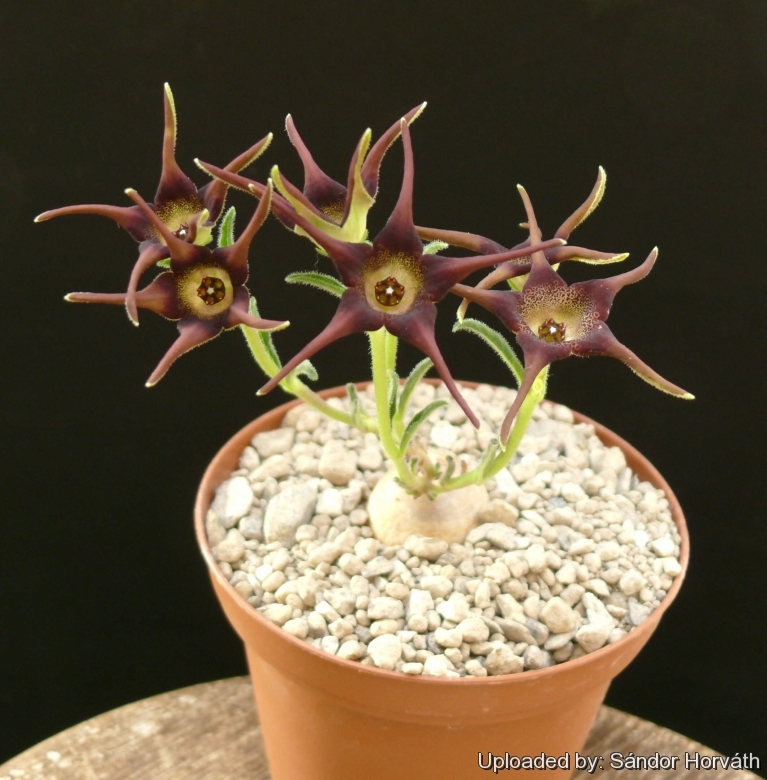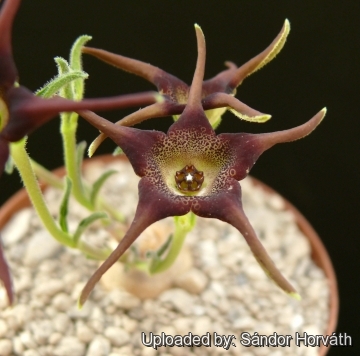




Your support is critical to our success.
- Encyclopedia of SUCCULENTS
- Encyclopedia Index
- Families
- Genera
- Species
- Asclepiadaceae
- Brachystelma
- Caudiciforms
Since 4 Aug 2013

Origin and Habitat: Brachystelma foetidumSN|32328]]SN|32328]] has a wide distribution in South Africa (Free State, Gauteng, KwaZulu-Natal, Limpopo, North West), it is also found in Zimbabwe, Lesotho and Malawi. Brachystelma foetidumSN|32328]]SN|32328]] was collected early in the 20th century by Anna Dieterlen from near Leribe Mission in Lesotho.
Habitat and ecology: Occurs in meadows and in open forests on flats and hillsides.
Synonyms:
- Brachystelma foetidum Schltr.
Brachystelma foetidum Schltr.
Bot. Jahrb. Syst. 20: Beibl. n. 51 52 (1895)
Synonymy: 2
- Brachystelma foetidum Schltr.
- Brachystelma rehmannii Schltr.
ENGLISH: Hottentot's bread, Hottentots Bread
AFRIKAANS (Afrikaans): Hotnotsbrood, Hottentotsbrood
Description: Brachystelma foetidum is a perennial herbaceous plant. It is a geophyte growing from a large flattened tuber (caudex), bearing a single or many, erect or prostrate, hairy, annual stems to 15 cm in height or length. The leaves are lanceolate to elliptical to 30 mm long and 10 mm broad, and tapper at the base into a short petiole. The lower leaf surface and the leaf margins are hairy, leaf upper side is smooth. Flowers 2-6 together, bell-shaped with elongated lobes spreading, purple-brown but highly variable comprising small-flowered specimen with the inner surface of the corolla-lobes glabrous, and large-flowered specimen with the inner surface of the corolla-lobes puberulous but this extreme forms are connected by specimens with flowers of intermediate sizes, influenced no doubt by the environment and seasonal variations. Brachystelma foetidumSN|32322]]SN|32328]] is one of those species whose presence at flowering time is revealed at a great distance because of an abominable carrion-like stink also described as an intense manure odour or an awful stench. A single, blooming plant may completely contaminate a large greenhouse!
Derivation of specific name: foetidum (Latin), bad-smelling.
Tuber (caudex): Round, flattened, up to10-12(-20) cm diameter, generally hidden deep in the soil, often with slightly bowl-shaped central area.
Stem: Aerial shoot solitary to several, somewhat branched above, 7-15 cm high, variably pubescent with short spreading hairs.
Leaves: Arranged in an alternate or opposite position, spreading, 12-30(-50) mm long, 3-10(-16) mm broad, linear-lanceolate, lanceolate, somewhat elliptic or ovate, acute or obtuse, cuneately narrowed at the base into a short petiole, longitudinally folded, sometimes undulate at the margins, pubescent on both sides or glabrous above.
Flowers: Hermaphrodite, complete, radially symmetric. The flowers appear singly or in twos in terminal position and produce an extension in the form of an axil shoot, which in turn produces an 2–6-flowered inflorescence. The flowers are highly variable in regard to size, color, and markings. Pedicels 05-10 mm long, pubescent. Sepals 3-5 mm long, lanceolate, acute, pubescent. Corolla 25-50 mm in expanse, pubescent to subglabrous all over outside, inner surface of lobes and tube glabrous (rarely puberulous), dark purple-brown or nearly black on the lobes and marked with purple-brown wart-spots (not always visible in dried flowers) on a white or yellowish ground in the tube. Tube 6-8(-10) mm long, broadly dish-shaped to campanulate white to yellowish within, with purple-brown warty spots, becoming dark purple-brown to nearly black on lobes. Corolla lobes free, spreading, 12-24 mm long, linear from a deltoid base, with revolute or reflexed margins, acute, ciliate with hairs like those on the back dark purple with greenish tips or uniformly olive-green. Outer corona forming 5 pockets with V-shaped outer margin, about equalling the staminal column, somewhat cup-like, 10-toothed or of 5 bifid lobes forming small pockets alternating with the anthers, apparently purple-brown; teeth erect, 0.5-0-75 mm long, deltoid, acute or obtuse, usually pubescent on the inner face with minute white hairs (scarcely visible when wetted) or sometimes glabrous; inner corona lobes up to 1 mm long, linear, obtuse, incumbent on the backs of the anthers and not exceeding them, glabrous. The pollinia are approximately shaped like a pear, attached by short caudicles to carrier.
Blooming season: Winter (October - January.)
Fruits (follicles): In pairs or solitary, 6-12 cm long, 5-6 mm or more thick, terete-fusiform, tapering into an obtuse beak, pubescent.
Related species: Brachystelma foetidumSN|32328]]SN|32328]] is closely related to Brachystelma megasepalumSN|32328]]SN|32322]] and Brachystelma petraeum.
Bibliography: Major references and further lectures
1) Nicholas Edward Brown: Asclepiadaceae. In: William T. Thiselton-Dyer (Hrsg.): "Flora Capensis : being a systematic description of the plants of the Cape Colony, Caffraria and Port Natal (and neighbouring territories)." Volume 4, Sect. 1 Vaccinaceae to Gentianeae. Reeve, London 1905–1909
2) Focke Albers, Ulrich Meve “Illustrated Handbook of Succulent Plants: Asclepiadaceae: Asclepiadaceae”, Volume 4 Springer Science & Business Media, 2002
3) Dyer, R.A. 1980. “Brachystelma, Ceropegia and Riocreuxia.” In: O.A. Leistner (ed). Flora of Southern Africa 27 Part 4:1-88. Botanical Research Institute, Pretoria.
4) Dyer, R.A. 1983. “Ceropegia, Brachystelma and Riocreuxia in southern Africa.” A.A. Balkema, Rotterdam, Netherlands.
5) J.P. Roux “Flora of South Africa”, 2003
6) Rudolf Schlechter “Beiträge zur Kenntnis südafrikanischer Asclepiadaceen. IV. Aufzählung der von mir auf meiner letzten Reise durch Natal und Transvaal gesammelten Asclepiadaceen.” In: Botanische Jahrbücher für Systematik, Pflanzengeschichte und Pflanzengeographie. Berlin 20(51): 7-56, 1895.
7) Gerrit Germishuizen “Transvaal Wild Flowers” Macmillan South Africa (Publishers), 1982
8) Scott-Shaw, C.R. 1999. “Rare and threatened plants of KwaZulu-Natal and neighbouring regions.” KwaZulu-Natal Nature Conservation Service, Pietermaritzburg.
9) Foden, W. & Potter, L. 2005. “Brachystelma foetidum Schltr.” National Assessment: Red List of South African Plants version 2015.1. Accessed on 2016/01/14
10) David Ambrose “Floras, plant diversity & taxonomy” House 9 Publications, National University of Lesotho, 2007
11) Françoise Malaisse “How to live and survive in Zambezian open forest (Miombo ecoregion)” Presses Agronomiques de Gembloux, 2010
12) Werner Rauh “The Wonderful World of Succulents: Cultivation and Description of Selected Succulent Plants Other Than Cacti” Smithsonian Institution Press, 1984

Brachystelma foetidum Photo by: Sándor Horváth
The gallery now contains thousands of pictures, however it is possible to do even more. We are, of course, seeking photos of species not yet shown in the gallery but not only that, we are also looking for better pictures than those already present. Read More...
Cultivation and Propagation: Brachystelma foetidumSN|32328]]SN|32328]] is hardy in cultivation.
Soil: It grows best in deep earthenware pots in a very draining but rich soil. An error in cultivation may produce unsightly holes in the tuber.
Exposure: In cultivation the plants are usually grown in semi shade, with the tubers wholly or (preferably) partially exposed to prevent scorching and rotting of the roots. When the plants are kept in half a day's sunlight their natural compact habit is maintained, a characteristic feature of most plants in habitat
Hardiness: It should be overwintered in the greenhouse at temperatures over 12°C (avoid letting temperatures drop lower than 5° C).
Water requirements: This plant can take a good deal of water during active growth and should be watered only when not dormant. Keep dryish in winter.
Traditional uses: The tuber is sometimes eaten by the Hottentots and called Hottentot's bread, when eaten raw it tastes bitter.
Reproduction: This species can be reproduced by seeds.
| Your Actions | |
|---|---|
| Back to Brachystelma index | |
| Back to Asclepiadaceae index | |
 |
Back to Succulents Encyclopedia index |
Privacy stantement - Terms and conditions - How to cite - About us - Feedback - Donate



